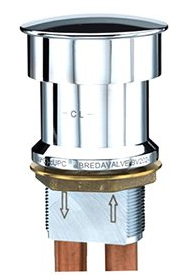WHAT CAUSES BACKFLOW?
Water in your plumbing system should only flow in one direction – forward. Backflow is caused by cross-connections that may allow contaminated water to enter the portable water supply, under certain conditions. To better understand backflow, imagine a home irrigation system that uses sprinklers to maintain a lawn.
Water contaminated with dirt, toxic fertilizers, and pesticides can form puddles around the sprinkler device and in case of a pressure drop, that contaminated water gets sucked back into the supply line and mix in with drinking water. Water from car washes, dry cleaners, and restaurants can sometimes seep back into the main line and contaminate the entire public supply. Here are two forms of Backflow:
Back pressure
Backpressure backflow occurs when downstream pressure from a non-potable water source exceeds the main water system pressure. When this happens, the water flowing downwards flows back into the main supply line. Heat expansions from boilers can sometimes cause the downstream pressure to increase, resulting in a backflow. Similarly, firefighting, line flushing, or a break in the main water line can reduce pressure in the portable supply line.
Back siphonage
A loss of pressure in your clean water supply can create a vacuum or partial vacuum, which leads to contaminated water being pulled back into the system. Backsiphonage occurs whenever there is a strain on the water supply due to nearby firefighting, repairs or breaks in the City Main, etc. Remember that a backflow can contaminate your clean water supply, and expose you as well as your community to pollutants that can make you severely sick.
How to Prevent Backflow?
Air gaps built into your plumbing help to maintain positive water pressure in the pipes to an extent but even they have their limitations. The most fail-safe way to prevent backflow is to install a backflow preventer that ensures that wastewater only flows in one direction and cannot force itself back up a pipe. Particularly when we talk about back siphonage, a vacuum pressure valve is one of the best backflow preventer devices on the market.
These backflow devices are installed in key areas of the plumbing system where clean water is most vulnerable to contamination by cross-connection. Especially if you have a sprinkler system installed at condo, a vacuum breaker valve helps to protect backflow of water from the irrigation system to your home’s freshwater supply.
A vacuum breaker valve needs to be installed anywhere where water is supplied for any use other than drinking water. You are required by law to install a vacuum breaker device on outside spigots, commercial dishwashing machines, and mop and dish sink sprayer hose spigots.
How Does a vacuum breaker valve work?
A vacuum breaker valve incorporates a check valve as well as an air inlet that is normally kept closed when the device is pressurized. The purpose of the check valve is to allow water through when it is flowing in the intended direction. However, if the air pressure exceeds the water pressure inside the system, the air inlet allows air to flow inside and break the suction effect of the low pressure that leads to siphonage.
A vacuum breaker device is usually installed above the highest point in the system, close to the water source, for it to be most effective. This is because highest points in the pipe are more vulnerable to these low-pressure conditions since pressure waves moving through the system lead to sudden upward or downward pressure surges.
All vacuum breakers are considered as high-hazard protection since they prevent contamination of all potable systems where they are installed. This is why vacuum breaker devices need to be frequently inspected and tested to ensure proper functioning. You can call in professionals to check your backflow devices and replace/repair as needed. The professional plumber will check if the check valve closes and the atmospheric vent opens as soon as the water supply is cut off. You can even check the vacuum breaker yourself by opening the bleed high valve by a mere ¼ turn, dropping the pressure slowly. Record pressure reading as soon as the air inlet valve opens. In a correct functioning valve, it should be higher than 1 PSI.
